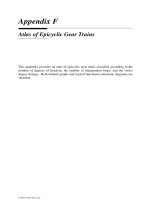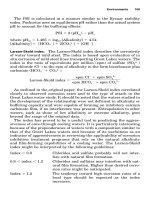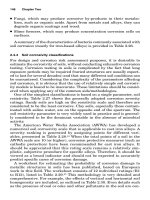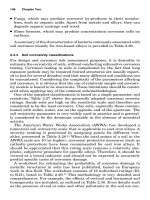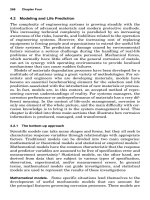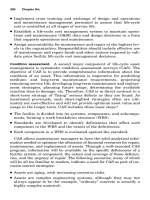Handbook Of Shaft Alignment Episode 1 Part 6 pot
Bạn đang xem bản rút gọn của tài liệu. Xem và tải ngay bản đầy đủ của tài liệu tại đây (1.08 MB, 30 trang )
The four bottles of hardener arrived and the pour began in earnest at 1245 h. The
procedure was to blend the liquids (epoxy and hardener) for 3 min and then slowly add
each bag of aggregate to the mixture as shown in Figure 3.47. Once the fourth bag of
aggregate was added, another 2 min of mixing was suggested before the grout should be
poured. An electric drill with a mixing blade was used to mix the contents. When the first
batch was mixed together, it became apparent that the mixture was very viscous (almost like
peanut butter). The drill motor quickly became overloaded and the windings began to
overheat and smoke. Another drill motor was at hand so the drills were swapped out and
by the second batch, it too became overheated. A larger drill motor was quickly found to
handle the mixing with one batch mixed at a time. After adding all the contents, the barrel
weighed around 250 lb, a little too heavy for two people to lift and pour directly into the
baseplate.
Because of the viscosity of the grout, the most effective way to pour was by hand, scooping
the grout out of the mixing barrel and then pouring it into a hole as shown in Figure 3.48.
After the barrel got half empty, it was light enough to be lifted by two people. We then would
fill up a 5 gal bucket and use it to pour while another one or two people would continue to
scoop it out with the smaller buckets (which were made with thick plastic 1 gal laundry
detergent containers). Thankfully, two barrels were available where one crew would pour the
grout whereas another crew would mix the next batch. Initially, each batch took 15 min from
the time the mix was started to the time the barrel was empty. After a quick calculation, it was
FIGURE 3.46 Protecting the baseplate and surrounding area with plastic covering.
FIGURE 3.47 Mixing the grout contents.
Piotrowski / Shaft Alignment Handbook, Third Edition DK4322_C003 Final Proof page 120 29.9.2006 5:53pm
120 Shaft Alignment Handbook, Third Edition
conveyed to the work crew that it would take 4 h to finish the pour, far in excess of the cure
time so additional personnel were called in to speed up the process as shown in Figure 3.49.
About the time the fifth batch was poured, we noticed that the wooden form around the
baseplate started to leak as shown in Figure 3.50. Thankfully, we had the foresight to have
some duct sealant at hand in the event that this happened and the leaks were plugged as
shown in Figure 3.51. It then took approximately 6 min for each batch with bodies scrambling
around feverishly mixing and pouring the grout. At 1530 h the final batch pour was made as
shown in Figure 3.52.
The top plate of the baseplate was designed with a slope toward the pump side so in the
event of a water leak, the water could drain off the base to prevent rust from damaging
the baseplate. Knowing this, we started the pour at the low end of the baseplate. Once the
entire baseplate was filled, the grout began to flow and seek its own level and we noticed that
the grout began to swell higher in the pour holes at the low end of the baseplate and drop
down at the high end as shown in Figure 3.53. As seen in Figure 3.54, we then topped off the
pour holes at the high end hoping that the epoxy would begin to harden at the low end where
the pour first began to prevent it from overflowing onto the top of the baseplate. The grout
indeed did begin to slowly harden and, in fact, became somewhat like a soft putty so it
was decided to begin carving off the grout that had leaked out around the form as shown in
Figure 3.55 and Figure 3.56.
FIGURE 3.48 Pouring the grout.
FIGURE 3.49 More people needed.
Piotrowski / Shaft Alignment Handbook, Third Edition DK4322_C003 Final Proof page 121 29.9.2006 5:53pm
Foundations, Baseplates, Installation, and Piping Strain 121
FIGURE 3.50 Grout leak around form.
FIGURE 3.51 Plugging the leak with duct sealant.
FIGURE 3.52 Finishing the pour.
Piotrowski / Shaft Alignment Handbook, Third Edition DK4322_C003 Final Proof page 122 29.9.2006 5:53pm
122 Shaft Alignment Handbook, Third Edition
FIGURE 3.53 Grout began swelling at low end.
FIGURE 3.54 Hand packing the grout.
FIGURE 3.55 Scraping off the excess grout while still in the putty stage.
Piotrowski / Shaft Alignment Handbook, Third Edition DK4322_C003 Final Proof page 123 29.9.2006 5:53pm
Foundations, Baseplates, Installation, and Piping Strain 123
The majority of the work crew then cleaned up and left. Two of us decided to stick around
to smooth off the grout at the pour holes as the grout began to harden, which began to
quickly accelerate about 1 h after the last pour had been made. Since the chemical reaction of
the epoxy grout is exothermic, the baseplate began to get warm, then somewhat hot. We also
began to notice that the epoxy began swelling out of all of the pour holes apparently from
expansion of the grout during hardening. Surface temperatures of the baseplate were taken
with an infrared pyrometer with temperatures ranging from 1278F to 1398F. The epoxy began
to harden very quickly around 1700 h, so it was decided to remove the protective plastic
sheeting from the top of the baseplate before the epoxy hardened completely. The epoxy had
also oozed out of the vent holes and by this time we had to chisel them off as shown in
Figure 3.57. Figure 3.58 and Figure 3.59 show the grout pour holes after the epoxy had cured.
A fan was placed to begin cooling off the baseplate overnight.
The next morning it was decided to take another set of optical alignment measurements on
the 8-ft pads to see if the baseplate had stayed in the same position prior to the addition of the
grout. Figure 3.60 shows the jig transit and optical scale target on the foot pads. The transit
was precision leveled and the line of sight was adjusted to buck back into the same elevation
plane by observing the adhesive backed target placed on a nearby building column when the
first set of measurements were taken as shown in Figure 3.61.
FIGURE 3.56 Scraping off the excess grout while still in the putty stage.
FIGURE 3.57 Chiseling off the excess grout.
Piotrowski / Shaft Alignment Handbook, Third Edition DK4322_C003 Final Proof page 124 29.9.2006 5:53pm
124 Shaft Alignment Handbook, Third Edition
FIGURE 3.58 Epoxy at grout pour hole.
FIGURE 3.59 Baseplate after clean up.
FIGURE 3.60 Jig transit set up to observe final elevations on foot pads.
Piotrowski / Shaft Alignment Handbook, Third Edition DK4322_C003 Final Proof page 125 29.9.2006 5:53pm
Foundations, Baseplates, Installation, and Piping Strain 125
Figure 3.62 shows the elevation data and the baseplate profiles before and after the grout
had hardened. Figure 3.63 shows the pump to be installed and Figure 3.64 the turbine to be
installed onto the baseplate.
As shown in Figure 3.62, the baseplate had distorted after the grout had been poured.
Notice that pad E did not change its position very much after the pour had been made. All of
the other pads changed their position with the pads in the center of the baseplate now much
lower than either end. The baseplate bowed downwards more in the center, a little at the west
end, and virtually none at the east end.
The following conclusions can be made:
1. The top surfaces of the four pump foot pads were, and still are not in the same plane.
2. The top surfaces of the four turbine foot pads were, and still are not in the same plane.
3. An 18 in. long precision machinists level is unable to span across two of the pump or
turbine foot pads to check for longitudinal and transverse levelness.
4. If a precision machinists level would have been used, the leveling process would have
gone on forever. Depending on which pad the machinists level was placed on and what
direction it was placed in, the baseplate would have to be re-leveled for each pad. Since
the pads are sloped differently, once one pad was precisely leveled, when the machinists
level was moved to another pad, it would be out of level.
5. Every effort was made to position the pump foot pads and the turbine foot pads in an
averaged level, coplanar, and parallel condition prior to grouting. This was achieved on
seven out of the eight foot pads. This could not have been achieved by the leveling
jackscrews alone. In several cases, the anchor bolt nuts had to be tightened to bend the
baseplate downward to achieve the desired elevation at certain foot pads. There were no
jackscrews or anchor bolts located at pad D to distort the baseplate at that position. All
anchor bolt nuts were tightened and the adjacent jackscrews tightened to hold the
baseplate in its pregrouted position.
6. Every effort was made to follow the installation guidelines set forth by the equipment
manufacturers, the grout manufacturer, and the procedures set by API Recommended
Practice 686. The objective was to completely fill the baseplate so the grout would bond
to the top of the concrete foundation and the underside of the baseplate.
By carefully studying the before and after baseplate profiles in Figure 3.62, it becomes
obvious that the baseplate changed its shape after the epoxy grout had cured. Our initial
FIGURE 3.61 Reference target on building column used to buck in to same elevation.
Piotrowski / Shaft Alignment Handbook, Third Edition DK4322_C003 Final Proof page 126 29.9.2006 5:53pm
126 Shaft Alignment Handbook, Third Edition
thoughts were that the baseplate may have moved upward due to the temperature increase
from the exothermic reaction of the epoxy. Instead, the opposite happened and it was not a
linear move. Upon curing, epoxy grout shrinks. Once the baseplate was filled and the epoxy
10 in.
Final pre and post-
grout surface elevation
and profile
Up
Side view
Bolt plane
Bolt plane
Bolt plane
Bolt plane
Bolt plane
Bolt plane
Pad A
Pad B
Pad C
Pad D
Pad E (before grout)
Pad G
Pad F
Pad H
Notes:
• All elevation data was captured
with a optical jig transit
• Elevataions were taken on each
pad at all four corners
• The “shoot for” elevation at the
bolt was set at 0.800Љ for the
pump pads and 17.800Љ for the
turbine pads
0.800 in. (pump)
17.800 in. (turbine)
0.790 in. (pump)
17.790 in. (turbine)
0.810 in. (pump)
17.810 in. (turbine)
0.820 in. (pump)
17.820 in. (turbine)
0.830 in. (pump)
17.830 in. (turbine)
0.840 in. (pump)
17.840 in. (turbine)
View looking north
Surface with
south edge
higher
Surface with
north edge
higher
Pump
Steam turbine
17.805 in. 17.799 in.
17.808 in.17.814 in.
17.859 in. 17.856 in.
17.862 in.17.865 in.
17.827 in.
17.839 in.
17.844 in.
17.831 in.
17.851 in.
17.851 in.
17.840 in.
17.836 in.
0.850 in. 0.857 in.
0.859 in.0.851 in.
0.821 in. 0.823 in.
0.827 in.0.817 in.
0.857 in. 0.859 in.
0.860 in.0.856 in.
0.823 in.
0.825 in.
0.826 in.
0.824 in.
Pad A
Pad B
Pad C
Pad D
Pad E
Pad GPad F Pad H
North
Top view
No. 15 BFW baseplate after grouting
Elevations
0.850 in. (pump)
17.850 in. (turbine)
0.860 in. (pump)
17.860 in. (turbine)
0.870 in. (pump)
17.870 in. (turbine)
0.880 in. (pump)
17.880 in. (turbine)
0.890 in. (pump)
17.890 in. (turbine)
Pad F
Pump
Steam turbine
17.800 in. 17.797 in.
17.803 in.17.812 in.
17.833 in. 17.832 in.
17.840 in.17.840 in.
17.787 in.
17.799 in.
17.800 in.
17.788 in.
17.807 in.
17.808 in.
17.796 in.
17.793 in.
0.802 in. 0.809 in.
0.810 in.0.802 in.
0.802 in. 0.800 in.
0.801 in.0.806 in.
0.806 in. 0.811 in.
0.811 in.0.807 in.
0.800 in. 0.799 in.
0.802 in.0.803 in.
Pad A
Pad B
Pad C
Pad D
Pad E
Pad GPad F Pad H
North
Top view
No. 15 BFW baseplate before grouting
Pregrout “shoot for” elevation
Post-grout best fit curve
Pad D
Pad B
Pad G
Pad C
Pad H
Pad E (after grout)
0.010 in. (10 mils)
FIGURE 3.62 (See color insert following page 322.) Elevation data and profiles before and after grout
pour.
Piotrowski / Shaft Alignment Handbook, Third Edition DK4322_C003 Final Proof page 127 29.9.2006 5:53pm
Foundations, Baseplates, Installation, and Piping Strain 127
bonded to the underside of the top surface of the baseplate, the grout shrunk and bowed the
1=2 in. thick top surface plate downward in the middle despite the fact that there were several
structural steel cross members in the baseplate design (see Figure 3.29).
Discussions took place on how to fix the out of level and noncoplanar surfaces of the foot
pads now that the baseplate was grouted. Suggestions were forwarded to field machine all of
the foot pads to make them level and coplanar. If this was to be done, optical alignment
equipment should be available to assist in periodically measuring the surfaces that would be
machined to achieve level, parallel, and coplanar foot pad surfaces. This however would be a
waste of time and money. Getting the foot pads flat and in the same plane assumes that the
surfaces on the underside of the pump and turbine are flat and in the same plane. Is this true?
No data was taken to verify this despite the comments of one of the equipment manufacturers:
‘‘This couldn’t possibly happen.’’ If you look at the photograph of the turbine in Figure 3.64,
you will notice that the turbine supports that will touch pads D and E are L-shaped plates
that are axially bolted to the lower turbine casting. If these bolts are loosened in the casting, it
is possible that these support plates could be moved due to any clearance between the shank
of the bolts and the holes cut into the support plates.
It was decided to set the turbine and pump onto the baseplate without machining and check
for any soft foot conditions using the procedures described in Chapter 5. Figure 3.65 shows
the soft foot map when the turbine and pump were set onto the base. Assuming the undersides
of the pump and turbine feet were flat and in the same plane, there should have been very little
FIGURE 3.63 Pump being installed on baseplate.
FIGURE 3.64 Turbine being installed on baseplate.
Piotrowski / Shaft Alignment Handbook, Third Edition DK4322_C003 Final Proof page 128 29.9.2006 5:53pm
128 Shaft Alignment Handbook, Third Edition
(if any) soft foot problems on the pump (pads A, B, F, G). Now look at the soft foot map in
Figure 3.65 and observe that the gaps at pad A indicate that the pump foot was not making
contact there. Therefore the undersides of the pump feet were not in the same plane. A similar
study of the turbine foot pad profile (pads C, D, E, H) and the soft foot map will illustrate
that the underside of the turbine feet was also not in the same plane.
I have had the opportunity (i.e., been allowed) to use optical alignment equipment a total of
four times measuring the four corners of all the foot pads and have seen similar conditions on
every baseplate checked this way. I also know that very few baseplate installations are done
with this rigorous of a measurement process and that carpenters levels, not machinists levels,
are frequently used and that very few people verify that a baseplate is indeed in level after the
installers say it was. I am also not sure how often a baseplate was checked for levelness after
the grout was poured.
It should now become obvious that this may indeed occur very frequently and that foot
pads quite likely have a tilt and or twist condition and that the surfaces are not coplanar and
that when the machinery is placed onto the uneven, twisted, tilted foot pads, that a flat piece
of shim stock will not correct a complex, wedge-shaped gap that will occur. It is difficult, but
not impossible to fix this. Chapter 5 will discuss the procedure for doing this.
Finally, what effect will a baseplate that is not in level within 2 mils=ft and 5 mils across the
entire baseplate have on the successful operation of the machine? If a drive system has a 50
mil slope across the entire baseplate, will the thrust bearings not be able to accept this slight
axial force from gravity? I do not prescribe installing baseplate with that radical a slope, but
attempting to achieve the tolerances set forth by manufacturers and professional organization
seems to be unachievable in the real world. Many may think that what was observed
during this particular installation does not occur very frequently, when in fact, it is pro-
bably quite common. Perhaps some rethinking needs to be done in soleplate and baseplate
installation specifications.
3.3 PROBLEMS TO LOOK FOR IN YOUR FOUNDATIONS AND BASEPLATES
A complete visual inspection should be made at least once a year of all rotating equipment
foundations, baseplates, piping, etc. Many of these problems are quite obvious as shown in
Figure 3.66 through Figure 3.71.
Pump
Steam turbine
Pad A
Pad B
Pad C
Pad D
Pad E
Pad GPad F Pad H
North
Top view
No. 15 BFW soft foot after grouting
11
12
9
9
2
0
2
0
0
0
2
4
25
29
0
0
0
0
0
0
3
0
8
3
2
0
0
0
Support foot
left loose
FIGURE 3.65 Soft foot map of pump and turbine.
Piotrowski / Shaft Alignment Handbook, Third Edition DK4322_C003 Final Proof page 129 29.9.2006 5:53pm
Foundations, Baseplates, Installation, and Piping Strain 129
FIGURE 3.66 Fan frame mistakenly designed with no soleplates imbedded in concrete resulting in no
contact between underside of frame and top of concrete in the inertia block.
FIGURE 3.67 During a torque check on an anchor bolt, it was discovered that the anchor bolt had
sheared and an attempt was made to tack weld the anchor bolt so no one would notice.
FIGURE 3.68 During a torque check on a steam turbine sway bar, the bolts threaded into the underside
of the outboard bearing were found to be loose. Channel iron was used for the sway bar and the wedge-
shaped washers would loosen after a short period of time from the vibration of the machine. The bolts
were tightened, the vibration on the outboard bearing would be acceptable for a period of time but as
the bolts began to loosen again, the vibration would steadily increase to unacceptable levels.
Piotrowski / Shaft Alignment Handbook, Third Edition DK4322_C003 Final Proof page 130 29.9.2006 5:53pm
130 Shaft Alignment Handbook, Third Edition
3.3.1 PIPING,DUCTWORK, AND CONDUIT STRAIN
Piping strain is a monumental problem in industry, difficult to detect on installed piping, and
time consuming to correct. The widely held design philosophy seems to be that piping should
be loosely constrained so it can move and grow wherever it wants. Many people are surprised
to learn that the vast majority of piping failures have occurred from cyclic fatigue, not from
tension, compression, or shear failures. Most of the piping supports in existence were installed
by pipe fitters who were just supporting the pipe before all the connections were made. Similar
strain problems can also occur on ductwork for fans and conduit for electric motors.
Excessive piping, ductwork, or conduit forces can:
1. Distort the machine case upsetting internal clearances between moving and stationary
parts of the machine
2. Cause the machine case to shift its position over a short (or long) period of time
disrupting the alignment condition
3. Cause the hold down bolts to loosen or shear along with the shim packs and dowel pins
if used
FIGURE 3.69 Inspection of the grout under the soleplate revealed that the grout had begun to
deteriorate. Apparently this was observed prior to this and precut shim stock was used to attempt to
correct the gap between the top of the grout and the underside of the soleplate, which is not recom-
mended. Also notice that the top of the anchor bolt is not fully engaged in the nut.
FIGURE 3.70 A misalignment condition between the motor and water pump caused the packing to leak.
Over time, the spraying water severely oxidized the pump casing and baseplate.
Piotrowski / Shaft Alignment Handbook, Third Edition DK4322_C003 Final Proof page 131 29.9.2006 5:53pm
Foundations, Baseplates, Installation, and Piping Strain 131
Static piping forces that result from improper fits cannot be detected by simple visual
inspection after the piping has been attached to a pump, compressor, or turbine. Looking at a
spring hanger and seeing that the spring is compressed does not indicate that the load is
within acceptable limits. Also, spring hangers can only support piping loads in one direction.
What if there are other forces acting in directions other than that through the axis of the
spring?
Even if expansion joints or flexible hose sections are included in the piping, these devices
can only accept forces in one or two planes of motion. Installing flexible piping sections may
be just an excuse for someone to do a poor piping installation. Furthermore, flex hose is more
susceptible to failure than rigid pipe.
FIGURE 3.71 A poorly designed frame fabricated from plate steel vibrated excessively and eventually
the angle iron support gussets broke loose from the concrete support holding the gearbox in position
putting the unit into a severe misalignment condition. The bearings failed on both machines and rather
than remove the concrete pedestal and provide a complete support for the gear and the motor, a pipe
and jackscrew were installed, which eventually failed after a short period of time.
Piotrowski / Shaft Alignment Handbook, Third Edition DK4322_C003 Final Proof page 132 29.9.2006 5:53pm
132 Shaft Alignment Handbook, Third Edition
Forces from the expansion or contraction of piping attached to rotating equipment
carrying fluids whose temperatures are above or below the temperature of the pipe when no
fluid is moving can be enormous and frequently cause drastic movement in the turbo
machinery from excessive forces at the connection points. The flanges and connections on
pumps, compressors, fans, etc., were never meant to bear the weight or strain of piping and
ductwork. They are fluid connection points. The piping must have adequate support mech-
anisms that bear the weight and strain of the piping in the vertical, lateral, and axial
directions. A good piping design engineer should never view a pump or a compressor flange
as an anchor point for the piping.
I know that this has never happened at your plant, but I have seen pipe fitters attach a 20 t
chain fall around one end of a pipe and the other end around an I-beam, pull the pipe into
place, install and tighten the flange bolts, and then remove the chain fall. Some of the piping
in industry is so poorly installed that the pipe fitter has to stand out of the way when the pipes
are disconnected from machinery for fear of getting hit by the pipe when it springs away from
the connection.
Figure 3.72 shows an adjustable piping anchor support. If the piping misalignment is too
excessive and you are not willing to fit the pipe properly, you may want to consider using
supports similar to this at the suction and discharge pipes on the pumps and compressors to
prevent the pipe from forcing the machinery out of alignment. If the piping strain is excessive
and there are no supports to hold the poorly fit pipe in place, there is no guarantee that the
equipment will stay aligned for long periods of time even if you do a great job aligning the
rotating machinery.
Feet of support base are
bolted firmly to
g
round
Axial adjustment
screws and locknuts
Horizontal adjustment
screws and locknuts
Vertical adjustment
screws and locknuts
Pipe
FIGURE 3.72 Adjustable piping support.
Piotrowski / Shaft Alignment Handbook, Third Edition DK4322_C003 Final Proof page 133 29.9.2006 5:53pm
Foundations, Baseplates, Installation, and Piping Strain 133
3.4 CHECKING FOR EXCESSIVE STATIC PIPING FORCES ON
ROTATING EQUIPMENT
Since a majority of rotating equipment is used to transfer liquids or gases, the connecting piping
will undoubtedly have an effect on the machinery and could potentially be another source of
machinery movement due to thermal expansion of the piping, reactionary forces from the
movement of the liquid in the piping itself, static weight of the piping, or piping that has not
been installed properly causing tension or compression at the piping–machine interface.
The forces that cause machinery to move from improper installation of piping can be
checked by using dial indicators to monitor both the horizontal and vertical movement of the
machine case. By placing indicators at each corner of the machine element, loosening all the
foundation bolts, and observing the amount of movement shown on the indicators, any
undesirable forces acting on the machine can be determined. If more than 2 mils of movement
is noticed, it may be possible to reposition the other elements in the drive train without
modifying the piping to eliminate this problem.
This movement can also be checked with a shaft alignment bracket attached to one shaft
with dial indicators positioned at the twelve o’clock and three o’clock positions, on the
adjacent shaft as shown in Figure 3.73 or it could be check using a magnetic base and dial
indicator set up to observe motion of the machine case itself as the foot bolts are loosened
with the piping attached as shown in Figure 3.74. Shaft or casing movement exceeding 2 mils
on any dial indicator is unacceptable after all the foot bolts have been loosened.
3.5 VISUAL INSPECTION CHECKLIST
On an annual basis (at least), the following inspection should be made on all rotating
machinery at your plant site:
1. Cracked concrete bases or support columns
2. Cracks propagating at concrete joints
3. Water seeping between baseplate and concrete foundation that could freeze and damage
the structure
4. Loose foundation bolts
5. Shim packs that worked loose
6. Rusty shims
FIGURE 3.73 Excessive piping stress test. (Align the machinery and then attach brackets or clamps to
one shaft and mount dial indicators in the vertical and horizontal position against the other shaft. Set
the indicators at zero, loosen the foot bolts holding the piped machine in place, and monitor the
indicators for any movement. Ideally less than 2 mils (0.002 in.) of movement should occur.)
Piotrowski / Shaft Alignment Handbook, Third Edition DK4322_C003 Final Proof page 134 29.9.2006 5:53pm
134 Shaft Alignment Handbook, Third Edition
7. Loose or sheared dowel pins
8. Paint on shims
9. Properly positioned piping hangars that carry the weight of the piping
10. Piping expansion joints that move freely to accept thermal or hydraulic movement
11. Loose piping flange bolts
3.6 HOW LONG WILL ROTATING MACHINERY STAYED
ACCURATELY ALIGNED?
As discussed in Chapter 1, periodic alignment checks will indicate if shifting is occurring.
Disappointingly, very few long-term studies of the alignment shifting of rotating machinery in
industry have been performed. It is logical to conclude that the shaft alignment will change if
there is a shift in the position of the foundation. This shifting can occur very slowly as the base
soils begin to compress from the weight and vibration transmitted from the machinery above.
It can also occur very rapidly from radiant or conductive heat transfer from the rotating
equipment itself heating the soleplate, concrete, and attached structure. There are documen-
ted case histories where drive trains were aligned well within acceptable alignment tolerances
and after a 4–6 h run, moved considerably out of alignment. Many people assume that
when rotating equipment is aligned when it is installed or rebuilt, the alignment will stay
stable forever.
FIGURE 3.74 Alternate piping stress check using magnetic base and indicator to observe case move-
ment when foot bolts are loosened with piping attached.
Piotrowski / Shaft Alignment Handbook, Third Edition DK4322_C003 Final Proof page 135 29.9.2006 5:53pm
Foundations, Baseplates, Installation, and Piping Strain 135
REFERENCES
Abel, L.W., Chang, D.C., and Lisnitzer, M., The design of support structures for elevated centrifugal
machinery, Proceedings of the Sixth Annual Turbomachinery Symposium, December 1977, Gas
Turbine Labs, Texas A&M University, College Station, TX, pp. 99–105.
Building Code requirements for Reinforced Concrete, ACI 318, American Concrete Institute.
Centrifugal Compressors for General Refinery Services, API Standard 617, American Petroleum
Institute, Washington, D.C., October 1973.
Centrifugal Pumps for General Refinery Service, API Standard 610, American Petroleum Institute,
Washington, D.C., March 1973.
Dodd, V.R., Total Alignment, Petroleum Publishing Company, Tulsa, Okla., 1975.
Encyclopedia Britannica, various volumes.
Essinger, J.N., A closer look at turbomachinery alignment, Hydrocarbon Processing, September 1973.
Kramer, E., Computations of vibration of the coupled system machine–foundation, Second Inter-
national Conference, September 1–4, 1980, The Institution of Mechanical Engineers and
A.S.M.E., Churchill College, Cambridge, England paper no. C300=80.
Massey, J.R., Installation of large rotating equipment systems—a contractor’s comments, Proceedings
of the Fifth Turbomachinery Symposium, October 1976, Gas Turbine Labs, Texas A&M Uni-
versity, College Station, TX.
Monroe, T.R. and Palmer, K.L., How to get a superior equipment installation for less money, Stay-
Tru
1
Services Inc., Houston, TX.
Murray, M.G., Better pump baseplates, Hydrocarbon Processing, September 1973.
Murray, M.G., Better pump grouting, Hydrocarbon Processing, February 1974.
Newcomb, W.K., Principles of foundation design for engines and compressors, A.S.M.E. paper
no. 50 OGP-5, April 1951.
Recommended Practices for Machinery Installation and Installation Design, 1st ed., API Recommended
Practice 686, PIP REIE 686, April 1996, American Petroleum Institute, Washington, D.C., 2005.
Renfro, E.M., Repair and rehabilitation of turbomachinery foundations, Proceedings of the Sixth
Annual Turbomachinery Symposium, December 1977, Gas Turbine Labs, Texas A&M Univer-
sity, College Station, TX, pp. 107–112.
Renfro, E.M., Five years with epoxy grouts, Proceedings of the Machinery Vibration Monitoring and
Analysis Meeting, June 26–28, 1984, Vibration Institute, New Orleans, LA.
Simmons, P.E., Defining the machine–foundation interface, Second International Conference, September
1–4, 1980, The Institution of Mechanical Engineers and A.S.M.E., Churchill College, Cam-
bridge, England, paper no. C252=80.
Sohre, J.S., Foundations for high-speed machinery, A.S.M.E. paper no. 62-WA-250, September 7, 1962.
Standard Specification for Deformed and Plain Billet Steel Bars for Concrete Reinforcement, ASTM
A615, American Society for Testing and Materials.
Swiger, W.F., On the art of designing compressor foundations, A.S.M.E. paper no. 57-A-67,
November 1958.
Whittaker, W., Concrete: the basics, Unisorb Technical Manual, 1980.
Whittaker, W., Preventing machinery installation problems, Manufacturing Engineering, April 1980.
Whittaker, W., Recommendations for grouting machinery, Plant Engineering, January 24, 1980.
Witmer, F.P., How to cut vibration in big turbine generator foundations, Power, November 1952.
Piotrowski / Shaft Alignment Handbook, Third Edition DK4322_C003 Final Proof page 136 29.9.2006 5:53pm
136 Shaft Alignment Handbook, Third Edition
4
Flexible and Rigid Couplings
One of the most important components of any drive system is the device connecting the
rotating shafts together known as coupling. As it is nearly impossible to maintain perfectly
collinear centerlines of rotation between two or more shafts, flexible couplings are designed to
provide a certain degree of yielding to allow for initial or running shaft misalignment. There is
a wide assortment of flexible coupling designs, each available in a variety of sizes to suit
specific service conditions.
The design engineer invariably asks why are there so many types and is one type better than
any other? Simply put, there is no perfect way to connect rotating shafts (so far!). As you
progress through this chapter, you will find that perhaps two or three different coupling types
will fit the requirements for your drive system. One coupling being better than another is a
relative term. If two or more coupling types satisfy the selection criteria and provide long,
trouble-free service, they are equal, not better. The ultimate challenge is for you to accura-
tely align shafts, not find a coupling that can accept gross amounts of misalignment to
compensate for your ineptitude.
The pursuit to effectively connect two rotating shafts dates back to the beginning of the
industrial era where leather straps and bushings or lengths of rope intertwined between pins
were the medium used to compensate for shaft misalignment. Several flexible coupling designs
emerged immediately after the introduction of the automobile from 1900 to 1920. As shaft
speeds increased, coupling designs were continually refined to accept the new demands placed
on them. As industrial competition became more severe, equipment downtime became a
major concern, and industry became increasingly more interested in their coupling failures
in an effort to prolong their operating lifespan.
Patents for diaphragm couplings date back to the 1890s but did not become widely used
until just recently as diaphragm design, material, and construction vastly improved. O-ring
type seals, and crowning of gear teeth in gear couplings came about during World War II.
The awareness and concern for coupling and rotating machinery problems are reflected
by the increase in technical information generated since the mid-1950s. Coupling designs
will continually be refined in the coming years with the ultimate goal of designing the
‘‘perfect’’ coupling.
4.1 COUPLING AND SHAFT MISALIGNMENT TOLERANCES—WHAT IS
THE DIFFERENCE?
It is important for the person selecting the coupling not to be confused by the term ‘‘allowable
misalignment’’ in a coupling. The coupling manufacturers will often quote information on
allowable misalignment for the coupling and not necessarily the equipment it is coupled to.
These tolerances seem to lull the user into a sense of complacency, leading one to believe that
accurate shaft alignment is not necessary as ‘‘ . . . the coupling can take care of any misalign-
ment’’ (famous last words).
Piotrowski / Shaft Alignment Handbook, Third Edition DK4322_C004 Final Proof page 137 6.10.2006 5:43pm
137
It is imperative that you can differentiate between coupling tolerances and alignment
tolerances. Coupling misalignment tolerances quoted by flexible coupling manufacturers
typically specify the mechanical or fatigue limits of the coupling or components of the
coupling. These misalignment tolerances are frequently excessive compared to the misalign-
ment tolerances specified in Chapter 5, which deal with the rotating drive system as a whole.
The misalignment tolerance guide shown in Figure 5.4 is concerned with the survivability of
not only the coupling, but also the shafts, seals, and bearings of the machinery over long
periods of time.
4.2 THE ROLE OF THE FLEXIBLE COUPLING
Exactly what is a coupling supposed to do? If a ‘‘perfect’’ coupling were to exist, what would
its design features include?
.
Allow limited amounts of parallel and angular misalignment
.
Transmit power
.
Insure no loss of lubricant in grease packed couplings despite misalignment
.
Be easy to install and disassemble
.
Accept torsional shock and dampen torsional vibration
.
Minimize lateral loads on bearings from misalignment
.
Allow for axial movement of shafts (end float) even under misaligned shaft conditions
without transferring thrust loads from one machine element to another or, in some cases,
limit the amount of end float to allow running at a motors magnetic center but prevent
end thrust in sleeve bearings not designed to tolerate this
.
Stay rigidly attached to the shaft without damaging or fretting the shaft
.
Withstand temperatures from exposure to environment or from heat generated by
friction in the coupling itself
.
Have ability to run under misaligned conditions (sometimes severe) when equipment is
initially started to allow for equipment to eventually assume its running position
.
Provide failure warning and overload protection to prevent coupling from bursting or
flying apart
.
Produce minimum unbalance forces
.
Have a minimal effect on changing system critical speeds
.
Be of materials capable of long life in the environment in which installed (e.g., do not use
austentite stainless steel disks in coupling installed on acid pumps)
4.3 WHAT TO CONSIDER WHEN SPECIFYING A FLEXIBLE COUPLING
Although some of the items listed below may not apply to your specific design criteria when
specifying a flexible coupling for a rotating equipment drive system, it is a good idea to be
aware of all of these items when selecting the correct coupling for the job.
.
Normal horsepower and speed
.
Maximum horsepower=torque being transmitted at maximum speed (often expressed as
hp=rpm)
.
Misalignment capacity parallel, angular, and combinations of both parallel and angular.
.
Can the coupling accept the required amount of ‘‘cold’’ offset of the shafts without failure
during startup?
.
Torsional flexibility
.
Service factor
Piotrowski / Shaft Alignment Handbook, Third Edition DK4322_C004 Final Proof page 138 6.10.2006 5:43pm
138 Shaft Alignment Handbook, Third Edition
.
Temperature range limits
.
How is the coupling attached to the shafts?
.
Size and number of keyways
.
Type and amount of lubricant (if used)
.
Type and design of lubricant seals
.
Actual axial end float on rotors
.
Allowable axial float of shafts
.
Actual axial thermal growth or shrinkage of rotors
.
Type of environment coupling will be exposed to
.
Will coupling be subjected to radial or axial vibration from the equipment?
.
Diameter of shafts and distance between shafts
.
Type of shaft ends (straight bore, tapered, threaded, etc.)
.
Starting and running torque requirements
.
Are the running torques cyclic or steady state?
.
Where is a failure likely to occur and what will happen?
.
Noise and windage generated by the coupling
.
Cost and availability of spare parts
.
Lateral and axial resonance’s of the coupling
.
Coupling guard specifications for size, noise, and windage control
.
Installation procedure
.
Moments of inertia
.
Heat generated from misalignment, windage, friction
.
Intermittent high starting torque in some cases
4.4 TYPES OF FLEXIBLE COUPLINGS
The couplings found in this chapter show some of the commonly used couplings in industry
today but in no way reflect every type, size, or manufacturer. The information presented for
each coupling concerning capacity, maximum speeds, shaft bore diameters, and shaft-to-shaft
distances are general ranges and do not reflect the maximum or minimum possible values
available for each coupling design.
There are four broad categories of flexible couplings:
1. Miniature
2. Mechanically flexible
3. Elastomeric
4. Metallic membrane=disk
Misalignment capacities will not be given for a variety of reasons:
1. Manufacturers of similar couplings do not agree or publish identical values for angular
or parallel misalignment.
2. Manufacturers rarely specify if the maximum values for angular misalignment and
parallel misalignment are stated separate or a combination of the angular and parallel
values stated.
3. It is the intent of this book to provide the reader with the ability to obtain alignment
accuracies well within the limits of any flexible coupling design.
Coupling manufacturers assume that the user will operate the coupling within their stated
maximum misalignment values. If your rotating equipment or coupling has failed due to
Piotrowski / Shaft Alignment Handbook, Third Edition DK4322_C004 Final Proof page 139 6.10.2006 5:43pm
Flexible and Rigid Couplings 139
excessive misalignment, it is your fault. Good luck trying to get the coupling manufacturer to
pay for the damages!
This does not infer that all couplings accept the same maximum misalignment amounts or that
these allowable values should not influence the selection of a coupling. Always consult with your
coupling vendor or manufacturer about your specific coupling needs. If you are not getting the
satisfaction you feel, you need to properly select a coupling, consult a variety of manufacturers
(or end users) to comment on design selection or problem identification and elimination.
Although there are a variety of coupling designs that accommodate fractional horsepower
devices such as servomechanisms, this chapter will primarily show flexible couplings used on
high horsepower, high-speed turbomachinery. However, to give the reader an idea of the
design differences between the fractional and higher horsepower couplings, Figure 4.1 illus-
trates a few of the fractional horsepower designs.
FIGURE 4.1 Miniature flexible couplings. (Courtesy of Guardian Industries, Michigan, IN (b). With
permission.)
Piotrowski / Shaft Alignment Handbook, Third Edition DK4322_C004 Final Proof page 140 6.10.2006 5:43pm
140 Shaft Alignment Handbook, Third Edition
4.4.1 MECHANICALLY FLEXIBLE COUPLING DESIGNS
4.4.1.1 Chain Couplings
The chain coupling is basically two identical sprockets with hardened teeth connected by
double width roller or ‘‘silent’’ type chain. Packed grease lubrication is primarily used with
this type of construction necessitating a sealed sprocket cover. A detachable pin or master
link allows for removal of the chain. Clearances and flexing of the rollers and sprocket allow
for misalignment and limited torsional flexibility.
.
Capacity: to 1000 hp at 1800 rpm (roller), 3000 hp at 1800 rpm (silent).
.
Maximum recommended speed: up to 5000 rpm.
.
Shaft bores: up to 8 in.
.
Shaft spacing: determined by chain width, generally 1=8to1=4 in.
.
Special designs and considerations: Wear generally occurs in sprocket teeth due to
excessive misalignment or lack of lubrication. Torsional flexibility limited by yielding
of chain.
Advantages:
.
Easy to disassemble and reassemble
.
Fewer number of parts
Disadvantages:
.
Speed limited due to difficulties in maintaining balancing requirements
.
Requires lubrication
.
Limited allowable axial displacement
4.4.1.2 Gear Couplings
The gear coupling consists of two hubs with external gear teeth that are attached to the shafts.
A hub cover or sleeve with internal gear teeth engages with the shaft hubs to provide the
transmission of power. Gear tooth clearances and tooth profiles allow misalignment between
shafts. Lubrication of the gear teeth is required and various designs allow for grease or oil as
the lubricant.
Gear couplings can also employ a spacer or spool piece in the event that greater
separation is needed or desired between shaft ends. The coupling hub with the external
gear teeth and its mating sleeve can be located on each shaft with the spool piece employing
rigid flanges at both ends or the coupling hubs with the external gear teeth and their mating
sleeves can be located on the spool piece with rigid flanged hubs on each shaft end as shown
in Figure 4.8.
.
Capacity: up to 70,000 hp.
.
Maximum recommended speed: up to 50,000 rpm
.
Shaft bores: up to 30 in.
.
Shaft spacing: up to 200 in.
Piotrowski / Shaft Alignment Handbook, Third Edition DK4322_C004 Final Proof page 141 6.10.2006 5:43pm
Flexible and Rigid Couplings 141
Spacer
(c)
Sleeve
Hub
FIGURE 4.2 Mechanically flexible couplings. [Courtesy of (a) Browning Mfg., Maysville, KY; (b)
Ramsey Products, Charlotte, NC; (c) Falk Corporation, Milwaukee, WI. With permission.]
(continued )
Piotrowski / Shaft Alignment Handbook, Third Edition DK4322_C004 Final Proof page 142 6.10.2006 5:43pm
142 Shaft Alignment Handbook, Third Edition
.
Special designs and considerations: A considerable amount of attention is paid to the
form of the tooth itself and the tooth ‘‘profile’’ has progressively evolved through
the years to provide minimum wear to the mating surfaces of the internal and external
gear sets.
FIGURE 4.2 (continued) Mechanically flexible couplings. [Courtesy of (d) Zurn Industries, Erie, PA;
(e) Dodge-Reliance Electric, Cleveland, OH; (f) Zurn Industries, Erie, PA. With permission.]
Piotrowski / Shaft Alignment Handbook, Third Edition DK4322_C004 Final Proof page 143 6.10.2006 5:43pm
Flexible and Rigid Couplings 143
To provide good balance characteristics, the tip of the external gear tooth is curved and
tightly fits into the mating internal gear hub cover. If the fit is too tight, the coupling will be
unable to accept misalignment without damaging the coupling or the rotating equipment. If it
is too loose, the excessive clearance will cause an imbalance condition. Obtaining a good fit
FIGURE 4.3 Elastomeric flexible couplings. [Courtesy of (a) Falk Corporation, Milwaukee, WI; (b)
Browning Mfg., Maysville, KY. With permission.]
(continued )
Piotrowski / Shaft Alignment Handbook, Third Edition DK4322_C004 Final Proof page 144 6.10.2006 5:43pm
144 Shaft Alignment Handbook, Third Edition

